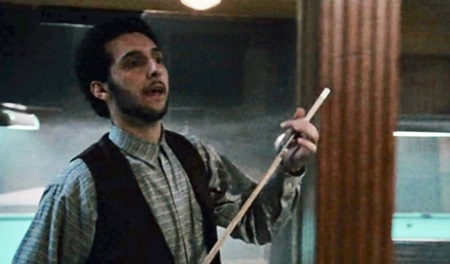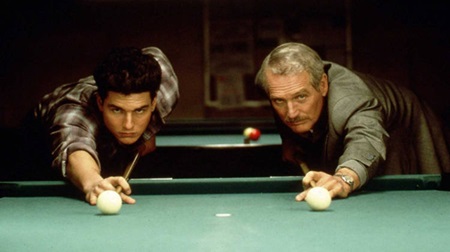With a sequel to the Robert Rossen directed The Hustler (1961) on tap some 25-years later, we look to Paul Newman reprising his role as “Fast” Eddie Felson in the Martin Scorsese directed movie The Color of Money (1986). With the original movie’s review here, we return to the notions of ambition and cockiness meeting the sporting world of billiards, with Tom Cruise starring as the up-and-coming pool player Vincent Lauria.

With the sequel based on the 1984 Walter Tevis book The Color of Money, the movie’s screenplay includes writing credits for Richard Price. The opening reintroduces Felson as a successful liquor salesman based in Chicago, Illinois. We witness Felson partner with a hustler named Julian, as portrayed by John Turturro. It’s when the charismatic Vincent Lauria with his sharp yet inexperienced at hustling pool players girlfriend, Carmen as portrayed by Mary Elizabeth Mastrantonio, get the better of Julian that “Fast” Eddie changes plans.

The plan calls for Felson to pitch Vincent, who had been working retail, to spend 6-weeks hustling their way through pool halls to a nine-ball tournament in Atlantic City, New Jersey. To sweeten the deal through manipulating Vincent’s feelings for Carmen, Eddie gives Vincent a high value Balabushka pool cue for saying yes. The acceptance and subsequent disappearance by ‘Fast’ Eddie for this bothers Julian as well as Felson’s girlfriend. Helen Shaver portrayed Felson’s girlfriend, Janelle.

The 6-week tour is fraught with the drama of Felson aiming to teach Lauria the art of hustling while Lauria bristles at the notion of playing below his ability to scam wealthy marks. As Felson, Lauria and Carmen are following Felson’s pool hall knowledge, vision, fronting, and experiences harkening back to the prequel movie The Hustler, the monetary gains and losses have been largely flowing going to Felson. The drama increases again when playing famed player Grady Seasons before Atlantic City raises questions of ego around this round of play as well as the play. Keith McCready portrayed Grady Seasons.

Taking inspiration from the experience between Vincent and Seasons, Felson starts playing again. Humiliated after getting taken by Amos, as portrayed by Forest Whitaker, Felson leaves enough money with Vincent and Carmen for the pair to make it to Atlantic City on their own. Felson takes his own path to New Jersey. Drama for Felson comes to a head between Felson and Lauria, Felson and Julian, and, finally, Felson and Janelle. Perhaps the biggest thing to come to a head is Felson relationship for the lifestyle and game of billiards, as confirmed by the film’s conclusion.

The means of a broken belief system restored, some 25-years later for ‘Fast’ Eddie Felson, was the message I felt mostly strongly in the pairing of movies that are The Hustler and The Color of Money. Having that context made for a better experience to the sequel than I would have had for the second movie as a stand alone experience. Being unwilling to separate the two, I grant The Color of Money as directed by Martin Scorsese 4.25-stars on a scale of 1-to-5.
Matt – Wednesday, January 31, 2024






